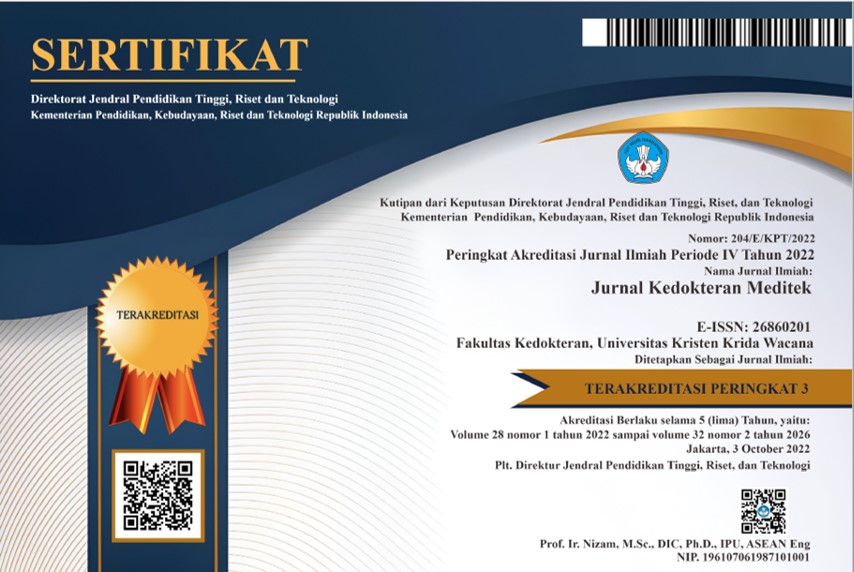Penggunaan Norepinefrin pada Fase Dini Terapi Syok Sepsis dengan Gagal Ginjal Akut
DOI:
https://doi.org/10.36452/jkdoktmeditek.v28i1.2219Keywords:
gagal ginjal akut, syok sepsis, vasopressorAbstract
Laporan Kasus ini memberi gambaran penggunaan norepinephrine awal dalam penanganan syok sepsis. Studi kasus melaporkan pria 65 tahun dengan keluhan nyeri perut dan tidak buang air kecil sejak 1 malam sebelum keluhan. Pasien didiagnosis dengan syok sepsis disebabkan perforasi gaster. Infus Vasopressor diberikan bersama cairan kristaloid. Panduan Surviving Sepsis Campaign (SSC) tahun 2018 merekomendasi pemberian antibiotik spektrum luas, pemberian cairan kristaloid segera, pemberian vasopresor setelah resusitasi cairan. Umumnya, cairan intravena diberikan terlebih dahulu diikuti pemberian vasopressor, namun pemberian vasopressor yang lebih awal mampu memberikan hasil yang memuaskan. Hasil pemeriksaan darah menunjukan peningkatan kadar serum ureum dan kreatinin disertai penurunan laju filtrasi glomerulus. Hasil terapi pada pasien cukup memuaskan, pasien dapat pulang dengan kondisi perbaikan. Studi kasus menunjukan pemberian vasopressor awal memberikan hasil terapi yang baik pada penanganan syok sepsis.
References
Singer M, Deutschman CS, Seymour CW, Shankar M, Annane D, Bauer M, et al. The third international consensus definitions for sepsis and septic shock (Sepsis-3). JAMA. 2016;315(8):801-10.
Torio CM, Andrews RM. National inpatient hospital costs: the most expensive conditions by payer, 2011. Statistical Brief #160.Healthcare Cost and Utilization Project (HCUP) Statistical Briefs.2013. [cited 2021 oct 1]. Available from: http HCUP-US Statistical Briefs (ahrq.gov)
Angus DC, van der Poll T. Severe sepsis and septic shock. N Engl J M. 2013;3(69):840-51.
Rhodes A, Evans LE, Alhazzani W, Levy MM, Antonelli M, Ferrer R, et al. Surviving sepsis campaign: international guidelines for management of sepsis and septic shock: 2016. Crit Care Med. 2017;45(3):486–552.
Cecconi M, De Backer D, Antonelli M, Beale R, Bakker J, Hofer C, et al. Consensus on circulatory shock andhemodynamic monitoring. Task force of the European Society of IntensiveCare Medicine. Intensive Care Med. 2014;40(12):1795–815.
Alobaidi R, Basu RK, Goldstein SL, Bagshaw SM. Sepsis-associatedacute kidney injury. Semin Nephrol 2015;35:2–11.
Uchino S, Kellum JA, Bellomo R, Doig GS, Morimatsu H, Morgera S,et al; Beginning and ending supportive therapy for the kidney (BEST Kidney) investigators. Acute renal failure in critically ill patients: amultinational, multicenter study. JAMA. 2005;294:813–8.
Bouchard J, Acharya A, Cerda J, Maccariello ER, Madarasu RC,Tolwani AJ, et al. A prospective international multicenter study of AKI in the intensive care unit. Clin J Am Soc Nephrol 2015;10:1324–31.
Bagshaw SM, Lapinsky S, Dial S, Arabi Y, Dodek P, Wood G, et al; Cooperative antimicrobial therapy of septic shock (CATSS) database research group. Acute kidney injury in septic shock: clinical outcomes and impact of duration of hypotension prior to initiation of antimicrobial therapy. Intensive Care Med 2009;35:871–81.
Fitzgerald JC, Basu RK, Akcan-Arikan A, Izquierdo LM, Piñeres Olave BE, Hassinger AB, et al; Sepsis prevalence, outcomes, and therapies study investigators and pediatric acute lung injury and sepsis investigators network. Acute kidney injury in pediatric severe sepsis: an independent risk factor for death and new disability. Crit Care Med. 2016;44:2241–50.
Levy MM, Evans LE, Rhodes A. The surviving sepsis campaign bundle: 2018
update. Intensive Care Med. 2018;44(6):925–8.
Smith SH, Perner A. Higher vs lower fluid volume for septic shock: clinical
characteristics and outcome in unselected patients in a prospective, multicenter cohort. Crit Care. 2012;16:R76. https://doi.org/10.1186/cc11333
Russell JA, Gordon AC, Walley KR. Early may be better: early low-dose
norepinephrine in septic shock. Am J Respir Crit Care Med. 2019;199(9):1049–51.
Finfer S, Liu B, Taylor C, Bellomo R, Cook D, Mcarthur C, et al. Resuscitation fluid use in critically ill adults: an international cross-sectional study in 391 intensive care units. Crit Care. 2010;14:R185.https://doi.org/10.1186/cc9293.
Peake SL, Delaney A, Bailey M, Bellomo R, Cameron PA, Cooper DJ, et al. Goal-directed resuscitation for patients with early septic shock. N Engl J Med. 2014;371(16):1496–506.
Ranjit S, Natraj R, Kandath SK, Kissoon N, Ramakrishnan B, Marik PE. Early norepinephrine decreases fluid and ventilatory requirements in pediatric vasodilatory septic shock. Indian J Crit Care Med. 2016;20(10):561–9.
Byrne L, Obonyo NG, Diab SD, Dunster KR, Passmore MR, Boon AC, et al. Unintended consequences: fluid resuscitation worsens shock in an ovine model of endotoxemia. Am J Resp Crit Care Med. 2018;198(8):1043–54.
Bai X, Yu W, Ji W, Lin Z, Tan S, Duan K, et al. Early versus delayed administration of norepinephrine in patients with septic shock. Crit Care. 2014;18(5):532.
Hamzaoui O, Jozwiak M, Geffriaud T, Sztrymf B, Prat D, Jacobs F, et al. Norepinephrine exerts an inotropic effect during the early phase of human septic shock. Br J Anaesth. 2018;120(3):517–24.
De Backer D, Pinsky M. Norepinephrine improves cardiac function duringseptic shock, but why? Br J Anaesth. 2018;120(3):421–4.
Maheshwari K, Nathanson BH, Munson SH, Khangulov V, Stevens M, Badani H, et al. The relationship between ICU hypotension and in-hospital mortality and morbidity in septic patients. Intensive Care Med. 2018;44(6):857–67.
Permpikul C, Tongyoo S, Viarasilpa T, Trainarongsakul T, Chakorn T, Udompanturak S. Early use of norepinephrine in septic shock resuscitation (CENSER). A randomized trial. Am J Respir Crit Care Med. 2019;199(9):1097–105.
Downloads
Published
How to Cite
Issue
Section
License
Copyright (c) 2022 Julian Welly, Ivy Jesslyn, Dennis Prakas

This work is licensed under a Creative Commons Attribution-NonCommercial-ShareAlike 4.0 International License.


















